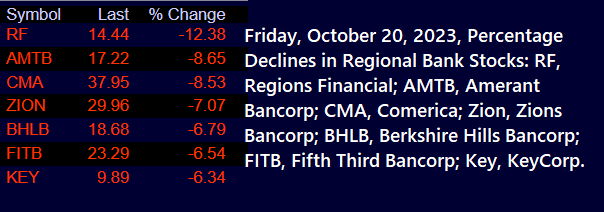by Pam Martens and Russ Martens, Wall St On Parade:

As the chart above indicates, Friday was not a good day to own regional bank stocks. The percentage declines are just for the one day of trading on Friday — not the year-to-date percentage losses. After the bank runs this past spring at regional banks brought on the second, third and fourth largest bank failures in U.S. history, things had quieted down in recent months. Then, along came earnings announcements last week, showing renewed struggles among the regional banks.
One of the big losers for the week was Zions Bancorp. Its shares plunged 9.7 percent on Thursday and another 7.07 percent on Friday. The bank posted poor year-over-year comparisons on net interest income as it experienced rising expenses to compete for deposits.
TRUTH LIVES on at https://sgtreport.tv/
Another plunging bank stock on Friday was Regions Financial. The bank is facing continuing pressure on its net interest income. The bank said it expects net interest income to fall by another 5 percent in the fourth quarter. Shares of the bank tumbled 12.38 percent on Friday.
Net interest income (NII) represents the difference between what a bank has to pay its depositors to retain their loyalty versus what it can charge on loans to borrowers. At regional lenders, which do not have the big trading operations of the Wall Street mega banks, NII represents their main source of profits.
Shares of Comerica dropped 8.53 percent on Friday after it posted earnings of $1.84 a share for the third quarter, a decline of 29 percent from its earnings in the third quarter of 2022. Comerica also lowered its projection for net interest income for the balance of the year.
Not helping the share prices of the regional banks last week was a speech that Federal Reserve Chairman, Jerome (Jay) Powell, delivered at an Economic Club of New York luncheon on Thursday. On the topic of inflation, Powell had this to say:
“My colleagues and I are committed to achieving a stance of policy that is sufficiently restrictive to bring inflation sustainably down to 2 percent over time, and to keeping policy restrictive until we are confident that inflation is on a path to that objective. We are attentive to recent data showing the resilience of economic growth and demand for labor. Additional evidence of persistently above-trend growth, or that tightness in the labor market is no longer easing, could put further progress on inflation at risk and could warrant further tightening of monetary policy.”
Higher interest rates would further dampen demand for loans at regional banks, which are already seeing lackluster demand for loans as interest rates have risen to 17-year highs. Higher rates would also worsen the unrealized losses that most banks, big and small, are experiencing on their holdings of debt securities. (See The Perfect Storm Hits Big Banks: Tumbling Deposits, Rising Unrealized Losses, and Higher-for-Longer Interest Rates.)
Early morning trading is suggesting another challenging week ahead for bank stocks, as well as the stock market in general. Dow futures were down more than 200 points this morning as the yield on the benchmark 10-year U.S. Treasury note spiked to a 16-year high of 5.022 percent. By 8:41 a.m. in New York, Dow futures had cut their losses to a negative 117 points and the 10-year U.S. Treasury note had trimmed its yield to 4.97 percent.
Read More @ WallStOnParade.com



